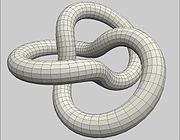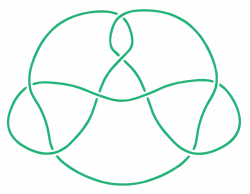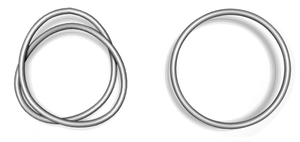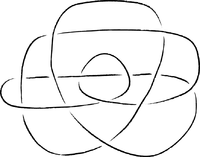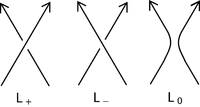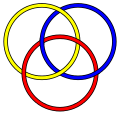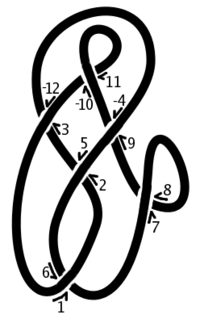
Knot theory
Background Information
SOS Children have produced a selection of wikipedia articles for schools since 2005. Child sponsorship helps children one by one http://www.sponsor-a-child.org.uk/.
Knot theory is the mathematical branch of topography that studies mathematical knots, which are defined as embeddings of a circle in 3-dimensional Euclidean space, R3. This is basically equivalent to a conventional knotted string with the ends joined together to prevent it from becoming undone. Two mathematical knots are equivalent if one can be transformed into the other via a deformation of R3 upon itself (known as an ambient isotopy); these transformations correspond to manipulations of a knotted string that do not involve cutting the string or passing the string through itself.
Knots can be described in various decisions. Given a method of reason, however, there may be more than one description that represents the same knot. For example, a common method of describing a knot is a planar diagram. But any given knot can be drawn in many different ways using a planar diagram. Therefore, a fundamental problem in knot theory is determining when two descriptions represent the same knot. One way of distinguishing knots is by using a knot invariant, a "quantity" which remains the same even with different descriptions of a knot.
The concept of a knot has been extended to higher dimensions by considering n-dimensional spheres in m-dimensional Euclidean space. This was investigated most actively in the period 1960-1980, when a number of breakthroughs were made. In recent years, low dimensional phenomena have garnered the most interest.
Research in knot theory began with the creation of knot tables and the systematic tabulation of knots. While tabulation remains an important task, today's researchers have a wide variety of backgrounds and goals. Classical knot theory, as initiated by Max Dehn, J. W. Alexander, and others, is primarily concerned with the knot group and invariants from homology theory such as the Alexander polynomial.
The discovery of the Jones polynomial by Vaughan Jones in 1984, and subsequent contributions from Edward Witten, Maxim Kontsevich, and others, revealed deep connections between knot theory and mathematical methods in statistical mechanics and quantum field theory. A plethora of knot invariants have been invented since then, utilizing sophisticated tools such as quantum groups and Floer homology.
In the last 30 years, knot theory has also become a tool in applied mathematics. Chemists and biologists use knot theory to understand, for example, chirality of molecules and the actions of enzymes on DNA.
History
Knots were studied by Carl Friedrich Gauss, who developed the Gauss linking integral for computing the linking number of two knots. His student Johann Benedict Listing, after whom Listing's knot is named, furthered their study. The early, significant stimulus in knot theory would arrive later with Sir William Thomson (Lord Kelvin) and his theory of vortex atoms. (Sossinsky 2002, p. 1-3)
In 1867 after observing Scottish physicist Peter Tait's experiments involving smoke rings, Thomson came to the idea that atoms were knots of swirling vortices in the æther. Chemical elements would thus correspond to knots and links. Tait's experiments were inspired by a paper of Helmholtz's on vortex-rings in incompressible fluids. Thomson and Tait believed that an understanding and classification of all possible knots would explain why atoms absorb and emit light at only the discrete wavelengths that they do. For example, Thomson thought that sodium could be the Hopf link due to its two lines of spectra. (Sossinsky 2002, p. 3-10)
Tait subsequently began listing unique knots in the belief that he was creating a table of elements. He formulated what are now known as the Tait conjectures on alternating knots. (The conjectures were finally resolved in the 1990s.) Tait's knot tables were subsequently improved upon by C. N. Little and T. P. Kirkman. (Sossinsky 2002, p. 6)
James Clerk Maxwell, a colleague and friend of Thomson's and Tait's, also developed a strong interest in knots. Maxwell studied Listing's work on knots. He re-interpreted Gauss' linking integral in terms of electromagnetic theory. In his formulation, the integral represented the work done by a charged particle moving along one component of the link under the influence of the magnetic field generated by an electric current along the other component. Maxwell also continued the study of smoke rings by considering three interacting rings.
When the luminiferous æther was not detected in the Michelson-Morley experiment, vortex theory became completely obsolete, and knot theory ceased to be of great scientific interest. Modern physics demonstrates that the discrete wavelengths depend on quantum energy levels.
Following the development of topology in the early 20th century spearheaded by Henri Poincaré, topologists such as Max Dehn, J. W. Alexander, and Kurt Reidemeister, investigated knots. Out of this sprang the Reidemeister moves and the Alexander polynomial.(Sossinsky 2002, p. 15-45) Dehn also developed Dehn surgery, which related knots to the general theory of 3-manifolds, and formulated the Dehn problems in group theory, such as the word problem. Early pioneers in the first half of the 20th century include Ralph Fox, who popularized the subject. In this early period, knot theory primarily consisted of study into the knot group and homological invariants of the knot complement.
A few major discoveries in the late 20th century greatly revived knot theory. The first was Thurston's hyperbolization theorem which introduced the theory of hyperbolic 3-manifolds into knot theory and made it of prime importance. Thurston's work also led, after much expansion by others, to the effective use of tools from representation theory and algebraic geometry. Important results followed, including the Gordon-Luecke theorem, which showed that knots were determined (up to mirror-reflection) by their complements, and the Smith conjecture.
Interest in knot theory from the general mathematical community grew significantly after Vaughan Jones' discovery of the Jones polynomial. This led to other knot polynomials such as the bracket polynomial, HOMFLY polynomial, and Kauffman polynomial. Jones was awarded the highest honour in mathematics, the Fields medal, in 1990 for this work.(Sossinsky 2002, p. 71-89) In 1988 Edward Witten proposed a new framework for the Jones polynomial, utilizing existing ideas from mathematical physics, such as Feynman path integrals, and introducing new notions such as topological quantum field theory (Witten 1989). Witten also received the Fields medal, in 1990, partly for this work. Witten's description of the Jones polynomial implied related invariants for 3-manifolds. Simultaneous, but different, approaches by other mathematicians resulted in the Witten-Reshetikhin-Turaev invariants and various so-called " quantum invariants", which appear to be the mathematically rigorous version of Witten's invariants (Turaev 1994).
In the early 1990s, knot invariants which encompass the Jones polynomial and its generalizations, called the finite type invariants, were discovered by Vassiliev and Goussarov. These invariants, initially described using "classical" topological means, were shown by 1994 Fields Medalist Maxim Kontsevich to result from integration, using the Kontsevich integral, of certain algebraic structures (Kontsevich 1993, Bar-Natan 1995).
These breakthroughs were followed by the discovery of Khovanov homology and knot Floer homology, which greatly generalize the Jones and Alexander polynomials. These homology theories have contributed to further mainstreaming of knot theory.
In the last several decades of the 20th century, scientists and mathematicians began finding applications of knot theory to problems in biology and chemistry. Knot theory can be used to determine if a molecule is chiral (has a "handedness") or not. Chemical compounds of different handedness can have drastically differing properties, thalidomide being a notable example of this. More generally, knot theoretic methods have been used in studying topoisomers, topologically different arrangements of the same chemical formula. The closely related theory of tangles have been effectively used in studying the action of certain enzymes on DNA. (Flapan 2000)
Knot equivalence
A knot is created by beginning with a one- dimensional line segment, wrapping it around itself arbitrarily, and then fusing its two free ends together to form a closed loop. When mathematical topologists consider knots and other entanglements such as links and braids, they describe how the knot is positioned in the space around it, called the ambient space. If the knot can be moved smoothly, without cutting or passing a segment through another, until it coincides with another knot, the two knots are considered equivalent. The idea of knot equivalence is to give a precise definition of when two embeddings should be considered the same.
The basic problem of knot theory, the recognition problem, can thus be stated: given two knots, determine whether they are equivalent or not. Algorithms exist to solve this problem, with the first given by Wolfgang Haken. Nonetheless, these algorithms use very many steps, and a major issue in the theory is to understand how hard this problem really is (Hass 1997). The special case of recognizing the unknot, called the unknotting problem, is of particular interest.
Knot diagrams
A useful way to visualise and manipulate knots is to project the knot onto a plane—think of the knot casting a shadow on the wall. A small perturbation in the choice of projection will ensure that it is one-to-one except at the double points, called crossings, where the "shadow" of the knot crosses itself once transversely (Rolfsen 1976). At each crossing we must indicate which section is "over" and which is "under", so as to be able to recreate the original knot. This is often done by creating a break in the strand going underneath.
Reidemeister moves
In 1927, working with this diagrammatic form of knots, J.W. Alexander and G. B. Briggs, and independently Kurt Reidemeister, demonstrated that two knot diagrams belonging to the same knot can be related by a sequence of three kinds of moves on the diagram, shown below. These operations, now called the Reidemeister moves, are:
- Twist and untwist in either direction.
- Move one strand completely over another.
- Move a strand completely over or under a crossing.
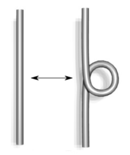 |
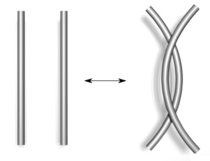 |
| Type I | Type II |
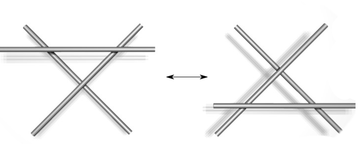 |
|
| Type III | |
Knot invariants
A knot invariant is a "quantity" that is the same for equivalent knots (Adams 2001, Lickorish 1997, Rolfsen 1976). An invariant may take the same value on two different knots, so by itself may be incapable of distinguishing all knots. An elementary invariant is tricolorability.
"Classical" knot invariants include the knot group, which is the fundamental group of the knot complement, and the Alexander polynomial, which can be computed from the Alexander invariant, a module constructed from the infinite cyclic cover of the knot complement (Lickorish 1997, Rolfsen 1976). In the late 20th century, invariants such as "quantum" knot polynomials and hyperbolic invariants were discovered. These aforementioned invariants are only the tip of the iceberg of modern knot theory.
Knot polynomials
A knot polynomial is a knot invariant that is a polynomial. Well-known examples include the Jones and Alexander polynomials. A variant of the Alexander polynomial, the Alexander-Conway polynomial, is a polynomial in the variable z with integer coefficients (Lickorish 1997).
Suppose we are given a link diagram which is oriented, i.e. every component of the link has a preferred direction indicated by an arrow. Also suppose  are oriented link diagrams resulting from changing the diagram at a specified crossing of the diagram, as indicated in the figure:
are oriented link diagrams resulting from changing the diagram at a specified crossing of the diagram, as indicated in the figure:
Then the Alexander-Conway polynomial, C(z), is recursively defined according to the rules:
- C(O) = 1 (where O is any diagram of the unknot)

The second rule is what is often referred to as a skein relation. To check that these rules give an invariant, one should determine that the polynomial does not change under the three Reidemeister moves. Many important knot polynomials can be defined in this way.
The following is an example of a typical computation using a skein relation. It computes the Alexander-Conway polynomial of the trefoil knot. The yellow patches indicate where we applied the relation.
gives the unknot and the Hopf link. Applying the relation to the Hopf link where indicated,
gives a link deformable to one with 0 crossings (it is actually the unlink of two components) and an unknot. The unlink takes a bit of sneakiness:
which implies that C(unlink of two components) = 0, since the first two polynomials are of the unknot and thus equal.
Putting all this together will show:
- C(trefoil) = 1 + z (0 + z) = 1 + z2
Since the Alexander-Conway polynomial is a knot invariant, this shows that the trefoil is not equivalent to the unknot. So the trefoil really is "knotted".
Actually, there are two trefoil knots, called the right and left-handed trefoils, which are mirror images of each other (take a diagram of the trefoil given above and change each crossing to the other way to get the mirror image). These are not equivalent to each other! This was shown by Max Dehn, before the invention of knot polynomials, using group theoretical methods (Dehn 1914). But the Alexander-Conway polynomial of each kind of trefoil will be the same, as can be seen by going through the computation above with the mirror image. The Jones polynomial can in fact distinguish between the left and right-handed trefoil knots (Lickorish 1997).
Hyperbolic invariants
William Thurston proved many knots are hyperbolic knots, meaning that the knot complement, i.e. the points of 3-space not on the knot, admit a geometric structure, in particular that of hyperbolic geometry. The hyperbolic structure depends only on the knot so any quantity computed from the hyperbolic structure is then a knot invariant. (Adams 2001)
Geometry lets us visualize what the inside of a knot or link complement looks like by imagining light rays as traveling along the geodesics of the geometry. An example is provided by the picture of the complement of the Borromean rings. The inhabitant of this link complement is viewing the space from near the red component. The balls in the picture are views of horoball neighborhoods of the link. By thickening the link in a standard way, we obtain what are called horoball neighborhoods of the link components. Even though the boundary of a neighborhoods is a torus, when viewed by inside the link complement, it looks like a sphere, called a horoball. Each link component shows up as infinitely many horoballs (of one colour) as there are infinitely many light rays from the observer to the link component. The fundamental parallelogram (which is indicated in the picture), tiles both vertically and horizontally.
The pattern of horoballs is itself a useful invariant. Other hyperbolic invariants include the shape of the fundamental paralleogram, length of shortest geodesic, and volume. Modern knot and link tabulation efforts have utilized these invariants effectively. Fast computers and clever methods of obtaining these invariants make calculating these invariants, in practice, a simple task. (Adams, Hildebrand, & Weeks, 1991)
Higher dimensions
In four dimensions, any closed loop of one-dimensional string is equivalent to an unknot. We can achieve the necessary deformation in two steps. The first step is to "push" the loop into a three-dimensional subspace, which is always possible, though technical to explain. The second step is changing crossings. Suppose one strand is behind another as seen from a chosen point. Lift it into the fourth dimension, so there is no obstacle (the front strand having no component there); then slide it forward, and drop it back, now in front. An analogy for the plane would be lifting a string up off the surface.
Since a knot can be considered topologically a 1-dimensional sphere, the next generalization is to consider a two dimensional sphere embedded in a four dimensional sphere. Such an embedding is unknotted if there is a homeomorphism of the 4-sphere onto itself taking the 2-sphere to a standard "round" 2-sphere. Suspended knots and spun knots are two typical families of such 2-sphere knots.
The mathematical technique called "general position" implies that for a given n-sphere in the m-sphere, if m is large enough (depending on n), the sphere should be unknotted. In general, piecewise-linear n-spheres form knots only in (n+2)-space ( Christopher Zeeman 1963), although this is no longer a requirement for smoothly knotted spheres. In fact, there are smoothly knotted 4k-1-spheres in 6k-space, e.g. there is a smoothly knotted 3-sphere in the 6-sphere (Haefliger 1962, Levine 1965). Thus the codimension of a smooth knot can be arbitrarily large when not fixing the dimension of the knotted sphere; however, any smooth k-sphere in an n-sphere with 2n-3k-3 > 0 is unknotted. The notion of a knot has further generalisations in mathematics, see: knot (mathematics).
Adding knots
Two knots can be added by cutting both knots and joining the pairs of ends. This can be formally defined as follows (Adams 2001): consider a planar projection of each knot and suppose these projections are disjoint. Find a rectangle in the plane where one pair of opposite sides are arcs along each knot while the rest of the rectangle is disjoint from the knots. Form a new knot by deleting the first pair of opposite sides and adjoining the other pair of opposite sides. The resulting knot is the sum of the original knots.
This operation is called the knot sum, or sometimes the connected sum or composition of two knots. The knot sum is commutative and associative. There is also a prime decomposition for a knot which allows us to define a prime or composite knot, analogous to prime and composite numbers. The trefoil knot is the simplest prime knot. Higher dimensional knots can be added by splicing the n-spheres. While you cannot form the unknot in three dimensions by adding two non-trivial knots, you can in higher dimensions, at least when one considers smooth knots in codimension at least 3.
Tabulating knots
Traditionally, knots have been catalogued in terms of crossing number. The number of nontrivial knots of a given crossing number increases rapidly, making tabulation computationally difficult. Knot tables generally include only prime knots and only one entry for a knot and its mirror image (even if they are different). The sequence of the number of prime knots of a given crossing number, up to crossing number 16, is 0, 0, 0, 1, 1, 2, 3, 7, 21, 49, 165, 552, 2176, 9988, 46972, 253293, 1388705... (sequence A002863 in OEIS). While exponential upper and lower bounds for this sequence are known, it has not been proven that this sequence is strictly increasing (Adams 2001).
The first knot tables by Tait, Little, and Kirkman used knot diagrams, although Tait also used a precursor to the Dowker notation. Different notations have been invented for knots which allow more efficient tabulation.
The early tables attempted to list all knots of at most 10 crossings, and all alternating knots of 11 crossings. The development of knot theory due to Alexander, Reidemeister, Seifert, and others eased the task of verification and tables of knots up to and including 9 crossings were published by Alexander-Briggs and Reidemeister in the late 1920s.
The first major verification of this work was done in the 1960s by John Horton Conway, who not only developed a new notation but also the Alexander-Conway polynomial (Conway 1970, Doll-Hoste 1991). This verified the list of knots of at most 11 crossings and a new list of links up to 10 crossings. Conway found a number of omissions but only one duplication in the Tait-Little tables; however he missed the duplicates called the Perko pair, which would only be noticed in 1974 by Kenneth Perko (Perko 1974). This famous error would propagate when Dale Rolfsen added a knot table in his influential text, based on Conway's work.
Alexander-Briggs notation
This is the most traditional notation, due to the 1927 paper of J. W. Alexander and G. Briggs and later extended by Dale Rolfsen in his knot table. The notation simply organizes knots by their crossing number. One writes the crossing number with a subscript to denote its order amongst all knots with that crossing number. This order is arbitrary and so has no special significance.
The Dowker notation
The Dowker notation, also called the Dowker-Thistlethwaite notation or code, for a knot is a finite sequence of even integers. The numbers are generated by following the knot and marking the crossings with consecutive integers. Since each crossing is visited twice, this creates a pairing of even integers with odd integers. An appropriate sign is given to indicate over and undercrossing. For example, in the figure the knot diagram has crossings labelled with the pairs (1,6) (3,−12) (5,2) (7,8) (9,−4) and (11,−10). The Dowker notation for this labelling is the sequence: 6 −12 2 8 −4 −10. A knot diagram has more than one possible Dowker notation, and there is a well-understood ambiguity when reconstructing a knot from a Dowker notation.
Conway notation
The Conway notation for knots and links, named after John Horton Conway, is based on the theory of tangles (Conway 1970). The advantage of this notation is that it reflects some properties of the knot or link.
The notation describes how to construct a particular link diagram of the link. Start with a basic polyhedron, a 4-valent connected planar graph with no digon regions. Such a polyhedron is denoted first by the number of vertices then a number of asterisks which determine the polyhedron's position on a list of basic polyhedron. For example, 10** denotes the second 10-vertex polyhedron on Conway's list.
Each vertex then has an algebraic tangle substituted into it (each vertex is oriented so there is no arbitrary choice in substitution). Each such tangle has a notation consisting of numbers and + or − signs.
An example is 1*2 −3 2. The 1* denotes the only 1-vertex basic polyhedron. The 2 −3 2 is a sequence describing the continued fraction associated to a rational tangle. One inserts this tangle at the vertex of the basic polyhedron 1*.
A more complicated example is 8*3.1.2 0.1.1.1.1.1 Here again 8* refers to a basic polyhedron with 8 vertices. The periods separate the notation for each tangle.
Any link admits such a description, and it is clear this is a very compact notation even for very large crossing number. There are some further shorthands usually used. The last example is usually written 8*3:2 0, where we omitted the ones and kept the number of dots excepting the dots at the end. For an algebraic knot such as in the first example, 1* is often omitted.
Conway's pioneering paper on the subject lists up to 10-vertex basic polyhedra of which he uses to tabulate links, which have become standard for those links. For a further listing of higher vertex polyhedra, there are nonstandard choices available.


